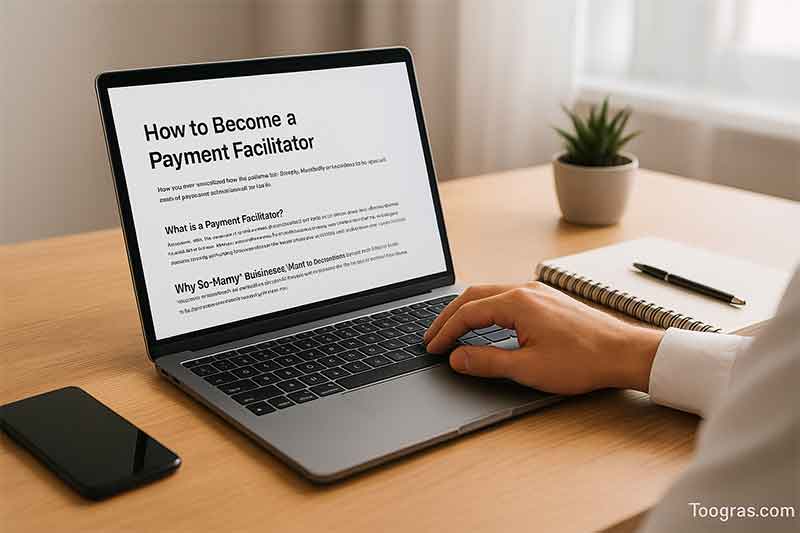How to Become a Payment Facilitator: A Simple, Clear, and Complete Guide
How to Become a Payment Facilitator: A Simple, Clear, and Complete Guide – Have you ever wondered how big platforms like Shopify, Mindbody, or Eventbrite let their users accept payments without sending them to a third-party processor? That magic happens because they act as payment facilitators, often called PayFacs. And the good news? You can become one too.
If you’re curious about how to become a payment facilitator, what it takes, and whether it’s worth the effort, this guide walks you through everything in a friendly, easy-to-understand way. No complicated finance talk. No confusing tech terms. Just a clear path to help you decide if this business model is right for you.
Let’s dive in.
What Is a Payment Facilitator?
A payment facilitator is a company that processes payments on behalf of smaller merchants. Instead of each merchant needing their own merchant account, they “ride” under your master account. You onboard them, underwrite them, and manage their payment experience.
Think of it like this: becoming a PayFac is similar to opening your own mini Stripe. You control the payment flow, the onboarding process, and the merchant experience.
This model is popular because it allows software companies to offer seamless payments inside their own platforms. It also creates a strong revenue stream, since PayFacs earn a cut from every transaction.
Why So Many Businesses Want to Become PayFacs
More companies are looking into how to become a payment facilitator because the payoff can be huge. Here are a few reasons this model is exploding:
You control the customer experience
Instead of redirecting users to a third-party payment form, you integrate payments directly into your software. This makes life easier for your users and feels much more professional.
You unlock new revenue streams
As a PayFac, you earn a portion of your users’ payment processing fees. If your software handles lots of transactions, those cents add up quickly.
Faster onboarding
Traditional merchant accounts can take days. PayFac onboarding? Minutes. People love speed.
You build a deeper relationship with customers
Payments are sticky. Once someone runs transactions through you, switching becomes harder. This boosts retention and long-term revenue.
But becoming a PayFac isn’t easy. It involves risk, money, compliance, and infrastructure. So let’s break down exactly what you need to do.
How to Become a Payment Facilitator: The Full Step-by-Step Guide
Here’s everything involved in becoming a PayFac, explained in simple, clear language.
1. Understand the PayFac Model Inside and Out
Before you jump in, it’s important to understand what you’re signing up for. Becoming a PayFac isn’t just adding a “Pay Now” button. You’re taking responsibility for:
- onboarding new merchants
- verifying their identity
- monitoring transactions
- managing fraud risk
- maintaining compliance
It’s not a side project. It’s a serious financial operation. But when done right, it can become one of your company’s strongest revenue engines.
2. Assess Your Business Fit
Not everyone needs to become a PayFac. Some businesses are better off partnering with existing processors like Stripe Connect or PayPal Commerce Platform.
Ask yourself a few simple questions:
- Does your platform handle payments for many smaller merchants?
- Would integrated payments improve your product experience?
- Do you want more control and more revenue from transactions?
- Do you have (or can you build) the technical talent needed?
If you’re nodding along, the PayFac route might be worth the investment.
3. Understand the Costs and Financial Requirements
Becoming a payment facilitator is not cheap. You need enough capital to absorb risks like chargebacks and fraud.
Common costs include:
- underwriting and compliance tools
- fraud detection systems
- legal fees
- software development
- risk reserves
- audits
- transaction monitoring tools
Most PayFacs start with at least $250k–$500k in capital. Larger ones invest millions. It depends on your risk appetite and business size.
4. Choose a PayFac Model: Full PayFac vs. Hybrid PayFac
There are two main paths:
Full PayFac
You take full control. You manage everything, including underwriting and risk. This offers the highest revenue but also the highest responsibility.
Hybrid PayFac
You partner with a provider who handles much of the heavy lifting. You still earn revenue, but you don’t need to build everything from scratch.
Many companies choose the hybrid model first to learn the ropes.
5. Build or Integrate the Required Infrastructure
Here’s the part where most people start sweating. A PayFac needs strong technology. Luckily, modern tools make things much easier.
Your system should include:
- an onboarding workflow
- KYC (Know Your Customer) checks
- KYB (Know Your Business) checks
- fraud monitoring
- transaction reporting
- dispute and chargeback management
- merchant dashboards
- secure payment APIs
Some companies build everything from the ground up. Others use provider tools like Finix, Payrix, or Stripe Connect Custom to fill the gaps.
6. Establish a Relationship With an Acquiring Bank
You can’t become a PayFac without an acquiring bank. They’ll be the backbone of your payment operations.
Banks handle:
- the flow of funds
- compliance oversight
- underwriting rules
- settlement timelines
This relationship can take months to set up. Banks are careful. They want to see financial stability, a solid business plan, and good security practices.
7. Create Your Merchant Onboarding Process
This is one of the biggest benefits of the PayFac model: you get to design the onboarding flow.
Your onboarding should be:
- fast
- intuitive
- compliant
- connected to identity checks
Remember, you’re responsible for who you approve. If one merchant commits fraud, you take the hit.
8. Implement Risk and Compliance Systems
This part isn’t fun, but it’s necessary.
Your PayFac must comply with:
- PCI DSS standards
- anti-money laundering (AML) rules
- KYC/KYB laws
- card network regulations
- ongoing monitoring requirements
If this sounds overwhelming, that’s normal. Many PayFacs work with specialized compliance companies to simplify everything.
9. Build Reporting and Settlement Tools
Merchants want to see:
- how much they earned
- pending payouts
- fees taken
- chargebacks
- past transactions
A clean dashboard goes a long way toward building trust.
10. Launch, Monitor, and Improve
Once you go live, the real work begins.
You’ll need to:
- monitor suspicious transactions
- handle disputes
- improve the onboarding flow
- review risk patterns
- keep your system stable
- update your software
Being a PayFac is an ongoing responsibility, but it pays off long-term.
How Long Does the Process Take?
On average, becoming a full PayFac takes 6–12 months. Sometimes longer. A hybrid model is faster, often 2–4 months.
Most of the time goes into:
- bank approvals
- compliance setup
- building your infrastructure
- testing your systems
If you’re in a hurry or want to test the market first, hybrid is the safest path.
What Skills Do You Need to Become a Payment Facilitator?
You don’t need to be a financial genius. But you’ll need a team with strengths in:
- software development
- cybersecurity
- compliance
- risk management
- customer support
If you’re running a SaaS platform, you already have half of what you need.
Pros and Cons of Becoming a PayFac
Let’s keep it simple.
Pros
- More revenue from each transaction
- Control over merchant experience
- Faster onboarding
- Stronger customer retention
- Big competitive advantage
Cons
- High startup costs
- Requires compliance expertise
- Heavy risk responsibility
- More complex operations
Is it worth it? For many SaaS companies, absolutely. Payments become a powerful long-term revenue engine that grows with your user base.
Real-World Examples of PayFacs
You see PayFacs every day, even if you don’t notice them.
- Shopify lets store owners accept payments instantly.
- Mindbody lets fitness studios take bookings and payments seamlessly.
- Toast embeds payments directly into restaurant POS systems.
They became PayFacs because integrated payments drive retention and profit.
Want to Explore More Business Operations Topics?
If you’re curious about how financial workflows impact other industries, you might enjoy related articles like car wash payment systems here: car wash payment systems.
You can also explore how payment structures work in different industries by reading guides such as roof payment schedule or learning about no payments for 90 days promotions.
Helpful External Resources
If you want to go deeper, these trusted sources offer more insight:
- Visa’s official guide to payment facilitators: visa.com
- PCI Security Standards Council: pcisecuritystandards.org
Both are excellent starting points for understanding compliance and security.
Final Thoughts: Is Becoming a PayFac Right for You?
Learning how to become a payment facilitator can feel like a huge task, but once you break it down, the path becomes much clearer. If your platform processes lots of payments, or you want tighter control over your user experience, becoming a PayFac can be one of the smartest long-term moves.
It’s not easy, and it’s definitely not cheap. But the rewards — more revenue, stronger customer loyalty, and a competitive edge — are worth the effort for many companies.
If you’re ready to explore this opportunity, start by mapping out your needs, choosing between full or hybrid PayFac, and talking with acquiring banks or PayFac-as-a-service providers.
Your future revenue engine might be one decision away.







